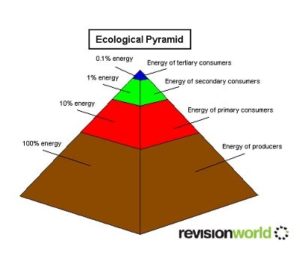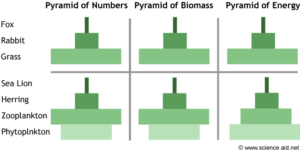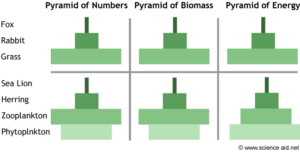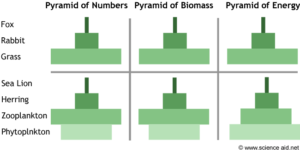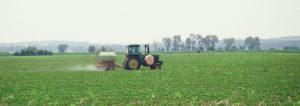Energy and Ecosystems
5.1 Food Chains and Food Webs
- Ultimate source of energy is sunlight converted to chemical energy by photosynthesising organisms then passed as food to other organisms
Producers
- Photosynthetic organisms that manufacture organic substances using light energy, water and CO2
- PHOTOSYNTHESIS EQUATION: 6CO2 + 6H2O + energy à C6H12O6 + 6O2
- Green plants are producers
Consumers
- All organisms that obtain energy by consuming other organisms
- Animals are consumers
- Those that directly eat producers are PRIMARY consumers – first in the chain
- Those that eat the primary consumers are secondary consumers
- Those that eat the secondary consumers are tertiary consumers
- Secondary and tertiary are usually predators but can also be scavengers or parasites
Decomposers
- Producers and consumers die and the energy they contain can be used when the complex materials are broken down into single components again
- In breaking these materials down they can be absorbed by plants and be recycled
- Majority of this is done by decomposers (fungi and bacteria) and some by detritivores (earthworms)
Food Chains
- Food chain – relationship in which producers are eaten by primary, who are eaten by secondary, who are eaten by tertiary.
- Longer chains may contain quaternary consumers
- Each stage in the chain is a trophic level
Food Webs
- Within a habitat many food chains will be linked together to form a food web
- Problem is their complexity
- A producer can be eaten by several different organisms etc.
- Charting all feeding inter-relationships is not feasible
- Also, these relationships are not fixed, they depend on times of the year
5.2 Energy Transfer Between Trophic Levels
- As little as 1% of the Sun’s energy is captured by green plants and so made available to organisms in the food chain
- These organisms then pass only a small fraction of the energy on that they receive to each successive trophic level
Energy Losses in Food Chains
- Plants normally convert 1-3% of the Sun’s energy into organic matter.
- Most of the Sun’s energy isn’t converted because:
- Over 90% of the Sun’s energy is reflected back into space by clouds and dust or is absorbed by the atmosphere
- Not all wavelengths of light can be absorbed and used for photosynthesis
- Light mightn’t fall on a chlorophyll molecule
- Might be limiting factor, e.g. CO2, stopping the energy being converted
- The total quantity of energy that plants produce in a community convert to organic matter is called the gross production
- However, 20-50% of this energy is used in the plant’s respiration, leaving little to be stored
- The rate at which plant’s store energy is called the net production
Net production = gross production – respiratory losses
- Even then only about 10% of this food stored in plants is used by primary consumers for growth
- Secondary and tertiary consumers are slightly more efficient, transferring about 20% of energy available into their own bodies
- The low percentage of energy transferred at each stage is the result of:
- Some of the organism isn’t eaten
- Some parts are eaten but can’t be digested so is lost in faeces
- Some of the energy is lost in excretory materials, e.g. urine
- Some energy losses occur as heat from respiration and directly from the body into the environment. These losses are higher in mammals and birds because of their high temps. Much more energy is needed to maintain their body temp.
- It is the relative inefficiency of energy transfer between trophic levels that explain why:
- Most food chains have only 4 or 5 trophic levels because insufficient energy is available to support a large enough breeding population at trophic levels higher than these
- The total mass of organisms in a particular place (biomass) is less at higher trophic levels
- The total amount of energy stored is less at each level
Calculating the Efficiency of Energy Transfers
- Energy available is usually measured in kilojoules per square metre per year (KJm-2year-1)
5.3 Ecological Pyramids
Pyramids of Number
- Usually, the numbers of organisms at lower trophic levels are greater than those at higher levels –shown by bars proportional to the number at each trophic level
- Significant drawbacks to using a number pyramid
- No account is taken of size – one tree is treated the same as an aphid and each parasite has the same numerical value as its larger host. This means sometimes it is not a pyramid at all
- The number of individuals can be so great that it’s impossible to represent them accurately on the same scale as other species in the food chain. E.g. one tree may have millions of greenfly living of it.
Pyramids of Biomass
- More reliable, quantitative description of a food chain where biomass is measured not numbers
- Biomass is the total mass of the plants and/or animals in a particular place
- Fresh mass is easy to asses but differing amounts of water present makes it unreliable – use dry mass instead BUT animals therefore have to be killed
- Because they need to be killed only a small sample is taken and so may not be representative
- Biomass is measured in grams per square metre (gm-2) where an area is being sample. When a volume is being sampled (in a pond or ocean) it’s measured in grams per cubic metre (gm-3)
- In both PoN and PoB only the organisms present at a particular time are shown, seasonal differences are not apparent
- This is particularly apparent when the biomass of some marine ecosystems arre measured
- Over the course of a whole year the mass of phytoplankton (plants) must exceed that of zooplankton (animals), but this is not seen at certain times of the year. E.g. in early spring around the British Isles, zoo plankton consume phytoplankton so rapidly that the biomass of zooplankton is greater than that of phytoplankton
Pyramids of Energy
- Most accurate representation of the energy flow through a food chain
- Measures the energy stored in organisms
- Collecting data can be difficult and complex
- Data are collected in a given area for a set period of time ( 1m2 for a year)
- Results are more reliable than those for biomass because two organism of the same dry mass may contain different amounts of energy. E.g. 1g of fat stores twice as much as 1g of carbohydrate
- An organism with more fat therefore has more energy even though their biomass is equal
- Energy flow is usually measured in KGm-2
5.4 Agricultural Ecosystems
- Agricultural ecosystems are largely made up of animals and plants used to produce food for mankind
- There are considerable energy losses at each trophic level and as we are third or even fourth in the chain we receive only a tiny proportion of the Sun’s energy
- Agriculture tries to ensure that as much of the available energy from the Sun as possible is transferred to humans
- It is channelling the energy flowing through a food web into the human food and chain and away from other food chains
- This increases the productivity of the human food chain
What is Productivity?
- Productivity ids the rate at which something is produced
- Plants are producers because the produce chemical energy by converting light energy into it during photosynthesis
- The rate at which plants assimilate this energy is called gross productivity, measured over a period of time for a given area usually in KJ m-2year-1
- About 20% of this energy is used in the plant’s respiration
- The remainder is net productivity
Net Productivity = Gross Productivity – Respiratory Losses
- Net productivity is affected by 2 main factors
- The efficiency of the crop at carrying out photosynthesis. This is improved if all necessary conditions for photosynthesis are supplied (no limiting factors)
- The area of the ground covered by leaves of the crop
Comparisons of Natural and Artificial Ecosystems
- Artificial ecosystems are based on the same ecological principles as natural but differ in several ways, the 2 basic ones are energy input and productivity
Energy Input
- In a natural ecosystem the Sun is the only source of energy
- Most of Britain’s land would be covered by forest if left to grow – a climax community
- To maintain an agricultural ecosystem this climax community is prevented from developing, this is done by excluding most of the species in that community, leaving only the crop you want to grow
- To remove or suppress the unwanted species and to maximise growth requires an additional input of energy
- This energy is used to plough fields, sow seeds, remove weeds, suppress pests and disease, feed and house animals, transport materials etc. and other tasks of farmers
- This additional energy comes in two forms
- Food – Farmers and farmhands expend energy as they work which comes from the food they eat
- Fossil fuels – As farms become more mechanised, energy increasingly comes from the fuel used to plough and harvest and transport crops, to apply fertilisers and pesticides and to feed, house and transport livestock
Productivity
- In natural ecosystems productivity is relatively low
- Additional energy put into agricultural ecosystems is used to increase the productivity of a crop by reducing the effect of limiting factors on its growth
- The energy used to remove all other species means the crop has no competition for light, CO2, minerals and the water which are all needed for photosynthesis
- The ground is therefore exclusively covered by the crop
- Fertilisers are added to provide essential ions and pesticides are used to destroy pests and prevent disease
- Together these factors mean that productivity is much higher in an agricultural ecosystem than in a natural one
| Natural Ecosystem | Agricultural Ecosystem |
| Solar energy only – no additional energy input | Solar energy plus energy from food (labour) and fossil fuels (machinery and transport) |
| Lower productivity | Higher productivity |
| More species diversity | Less species diversity |
| More genetic diversity within a species | Less genetic diversity within a species |
| Nutrients are recycled naturally within the ecosystem with little addition from outside | Natural recycling is more limited and supplemented by the addition of artificial fertilisers |
| Populations are controlled by natural means such as competition and climate | Populations are controlled by both natural means and by use of pesticides and cultivation |
| Is a natural climax community | Is an artificial community prevented from reaching its natural climax |
5.5 Chemical and Biological Control of Agricultural Pests
What Are Pests and Pesticides?
- Pest – organism that competes with humans for food and resources or it could be a danger to health
- Pesticides – poisonous chemicals that kills pests. They’re named after the pests they kill, herbicides kill plants, fungicides destroy fungi and insecticides kill insects
- An effective pesticide should:
- Be specific – so it’s only toxic to the organisms it is trying to destroy. It should be harmless to humans and other organisms, especially the natural predators of the pest, to earthworms and pollinating insects
- Biodegrade – so, once applied, it will breakdown into harmless substances in the soil. At the same time, it need to be chemically stable to last long
- Be cost-effective – because development costs are high and new pesticides are only useful for a limited time due to pests developing resistance, making the pesticide useless
- Not accumulate – so it doesn’t build up, either in specific parts of an organism or as it passes along the food chain
Biological Control
- It’s possible to control pest by using organism that are predators or parasites to the pest organism
- The aim is to control not eradicate the pest as it could be counter-productive
- If the pest is reduced too much, predators of the pest have insufficient food and so deplete
- Surviving pests would then multiply with barely any or no predators to eat them
- Ideally, the control agent and the pest should exist in balance with one another, at a level where the pest has little, or no, adverse effect
| Biological Disadvantages | Biological Advantages | Chemical Disadvantages | Chemical Advantages |
| Don’t act quickly – interval between introduction and reduction | Very specific | Always have some effect on non-target species | Effective straight away |
| Control organism may become a pest itself when there are no natural predators | Once introduced, the control organism reproduces itself | Must be reapplied at intervals, therefore expensive | |
| Pests do not become resistant | Pests develop genetic resistance, and new pesticides must be developed |
Integrated Pest-Control Systems
- Aim to integrate all forms of pest control instead of relying on one
- Emphasis is on finding an acceptable level of the pest rather than eradicating it. Eradication is costly, counter-productive and almost impossible
- Integrated control involves:
- Choosing animal or plant varieties that suit the local area and are as pest-resistant as possible
- Managing the environment to provide suitable habitats, close to the crop, for natural predators
- Regularly monitoring the crop for signs of pests so early action can be taken
- Removing the pests mechanically (hand-picking, vacuuming, erecting barriers) if the pest exceeds an acceptable population level
- Using biological agents if necessary and available
- Using pesticides as a last resort if pest populations start to get out of control
How Controlling Pests Affects Productivity
- Pests reduce productivity in agricultural ecosystems
- Weeds compete with plants for light, space, water, mineral ions and CO2
- As these are often in limited supply, any amount taken in by the pest means less is available for the crop plant
- One or more of them may become the limiting factor in photosynthesis, thus reducing the rate of photosynthesis and hence productivity
- Insect pests may damage the leaves of crops, limiting their ability to photosynthesise and again reduces productivity
- Alternatively, they may be in direct competition with humans, eating the crop itself
- Many crops are now grown in monoculture, and this enables insect and fungal pests to spread rapidly
- Pests of domesticated animals may cause disease
- The animals may not grow as rapidly, be unfit for human consumption or die – all of these lead to reduced productivity
- The aim of pest control is to limit the effect of pests on productivity to a commercially acceptable level
- In other words, to balance the cost of pest control with the benefits it brings
- The problem is that at least 2 different interests are involved: the farmer who has to satisfy our demand for cheap food while still making a living, and the conservation of natural resources, which will enable us to continue to have food in the future
- The trick is to balance these two, often conflicting, interests
5.6 Intensive Rearing of Domestic Livestock
Intensive rearing and energy conversion
- As energy passes through a food chain only a small percentage passes from one organism to the next
- This is because much of the energy is lost as heat during respiration
- IR of domestic livestock is converting the smallest possible amount of food energy into the greatest quantity of animal mass
- One way to achieve this is to minimise the energy losses from domestic animals during their lifetime
- This means more food energy will be converted into body mass to be passed on to the next link and eventually us
- Energy conversion can be made more efficient by ensuring that as much energy from respiration as possible goes into growth rather than other processes
- This is done by keeping animals in confined spaces, such as small enclosures, barns or cages – factory farming
- This increases the energy-conversion rate because:
- Movement is restricted – less energy is used in muscle contraction
- Environment can be kept warm in order to reduce heat loss from the body
- Feeding can be controlled so animals receive optimum amount and type of food for maximum growth with no wastage
- Predators are excluded so no loss to other organisms
- Other means of improving the energy-conversion rate include:
- Selective breeding of animals to produce varieties that are more efficient at converting the food they eat into body mass
- Using hormones to increase growth rates
Features of Intensive Rearing of Livestock
Food is essential for life and with an ever-expanding human population there is pressure to produce more food intensively. Main features include:
- Efficient energy conversion – by restricting wasteful loss of energy, more energy id passed along the food chain to humans
- Low cost – food such as meat, eggs and milk can be produced more cheaply than by other methods
- Quality of food – often argued that the taste of foods produced by intensive rearing is inferior to foods produced less intensively
- Use of Space – Intensive rearing uses less land while efficient production means that less of the countryside is required for agriculture, leaving more as natural habitats
- Safety – smaller concentrated units are easier to control or regulate. The high density animal populations are more vulnerable to the spread of disease but it’s easier to prevent infections being produced from the outside and to isolate the animals if this happens
- Disease – large numbers of animals living in close proximity means that infections can spread easily among them. To control this antibiotics are used
- Use of drugs – over-use of antibiotics to prevent disease has lead to antibiotic resistance. This can be transferred to bacteria that cause human disease, making their treatment with certain antibiotics ineffective. Other drugs may be given to animals to improve their growth or reduce aggressive behaviour and these can alter the taste of the food or pass into the foods and then into humans, affecting their health
- Animal welfare – the larger intensive farms have the resources to maintain a high level of animal welfare and are more easily regulated. However, animals are kept unnaturally and this may cause stress resulting in aggressive behaviour. This may cause them to harm themselves or others, which is why battery chickens are de-beaked. Restricted movement leads to osteoporosis and joint pain. The well-being of the animal is sacrificed for financial gain
- Pollution – Intensively reared animals produce large concentrations of waste in a small area. Rivers and ground water may become polluted. Pollutant gases may be dangerous or smell D:. Large intensive farms may have their own disposal facilities that enable them to treat waste more effectively than smaller non-intensive farms
- Reduced genetic diversity – selective breeding is used to develop animals with high energy-conversion rates and a tolerance of confined conditions. This reduces the genetic diversity of domestic animals, resulting in the loss of genes that might later prove to be beneficial
- Use of fossil fuels – High energy-conversion rates are possible because fossil fuels are used to heat the buildings that house the animals, in the production of the materials in the buildings (especially cement) and in the production and transportation of animal feeds. The CO2 emitted increases global warming.

